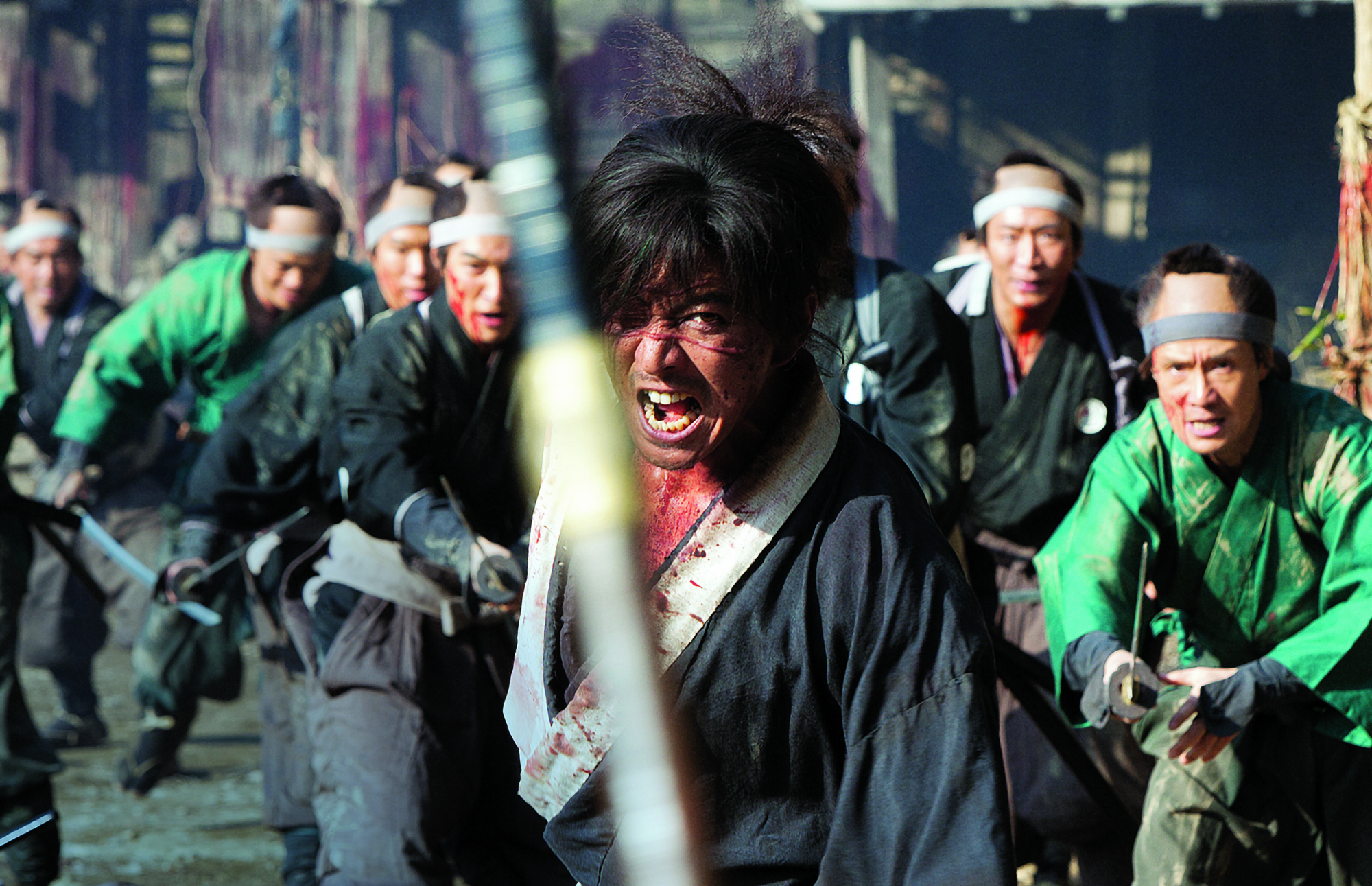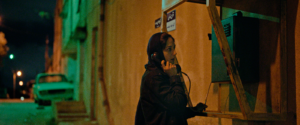Blade of the Immortal (2017) marks the 100th feature film by Takashi Miike. This number may be uncommon among his cinematic peers, but he breezed past it with no apparent effort – the film is, in fact, one of two that he completed last year, the other being JoJo’s Bizarre Adventure: Diamond Is Unbreakable – Chapter 1. A triple-digit filmography seems like an achievement more likely to be reached by a director with half a century (or more) of experience under their belt, or perhaps by an experimenter or maker of shorts, distributing their work to a bespoke audience through some obscure online platform. But Miike has only been working since the early 1990s and, though he cut his teeth in the wild frontiers of Japan’s quick and cheap direct-to-video market, he is by no means a private tinkerer. His films have increased in budget and logistical complexity since his younger days. He now regularly works with high-profile source material, international financiers and major stars. And he more than ever, to register a cultural impact outside his native Japan.
Blade played out of competition at the 2017 Cannes Film Festival, the fourth of his films to screen there over the past decade (with two others also having screened in the Directors’ Fortnight sidebar). Being feted on the Croisette might seem a strange turn of events for a filmmaker who made his earliest international impression with the perversely gruesome violence of works like Audition (1999) – in which a misogynistic widower receives an unforgettably grisly comeuppance at the hands of his new lover – and Ichi the Killer (2001), but Miike’s path to international respectability now appears natural if circuitous.

Blade follows an immortal, masterless samurai, Manji (Takuya Kimura, formerly of the popular boy band SMAP), who is engaged as the bodyguard of Rin Asano (Hana Sugisaki). Rin’s father has been killed by the warrior Anotsu Kagehisa (Sōta Fukushi), who leads a school of fighters known as the Ittō-ryū and has dedicated himself to eradicating all other schools of swordsmanship. Reluctantly drawn into Rin’s quest for revenge, the unkillable – but, per Miike’s taste for the theatrics of violence, elaborately woundable – Manji carves his way through a sequence of mano a mano duels as he hurtles towards a showdown with Anotsu.
The convoluted and rather-untidy plot mechanics appear to reflect the fact that the film was adapted from a long-running manga title – at almost two-and-a-half hours, Blade is overstuffed with incident – though, to be sure, Miike himself has an established tendency to allow his stories to stray freely. But the film is also lush in appearance and formally precise: Miike’s technical experience now seems fully ingrained. His skill at staging action is evident in the mass brawl that dominates Blade’s climax. Miike keeps his camera at a medium distance from the fighters, and a shallow frame hems Manji in to the centre of the crowd of surrounding warriors. Sword clashes are placed high and sharp in the sound mix, registering as loudly as gunshots.
Miike’s move into the chanbara mode is unexpected … he is perhaps offering a cultural performance of Japanese cinema on terms that an international audience is best conditioned to accept.
Blade is the third chanbara (or ‘sword fighting’) film that Miike has made in the past decade, after 2010’s 13 Assassins and 2011’s Hara-Kiri: Death of a Samurai (a remake of Masaki Kobayashi’s 1962 Harakiri). While these three works represent only a small portion of his credits in that time, they seem key in assessing his relatively newfound international status. Like 13 Assassins and Hara-Kiri, Blade was made in partnership with Recorded Picture Company,[1]Andreas Wiseman, ‘RPC Reteams with Takashi Miike on Blade of the Immortal’, Screen Daily, 13 February 2016, <https://www.screendaily.com/berlin/rpc-reteams-with-takashi-miike-on-blade-of-the-immortal/5100297.article>, accessed 14 February 2018. a British production outfit headed by producer Jeremy Thomas – an arrangement that helps explain these films’ rather luxe production values and far-flung distribution. Miike’s evolving status as international auteur – and recurring contributor to prestigious festivals like Cannes and Venice, and even the Melbourne International Film Festival – is no doubt due in part to his association with Thomas, who, as producer, has championed such arthouse-accredited directors as David Cronenberg, Bernardo Bertolucci, Jonathan Glazer and Ben Wheatley.
The chanbara genre today, scholar Andrew Dorman has argued, is a paradoxical one.[2]Andrew Dorman, Paradoxical Japaneseness: Cultural Representation in 21st Century Japanese Cinema, Palgrave Macmillan, London, 2016. A subset of the jidaigeki (‘period drama’) genre, chanbara is deeply culturally specific: films of this type tend to be set in the Edo period of 1603–1868 and depict a feudal Japan free from Western influence. But the chanbara has also, since the time of Akira Kurosawa’s 1954 Seven Samurai (and later cult objects like the 1972–1974 Lone Wolf and Cub series), been firmly established in the Western imagination as the quintessential Japanese film mode, with the central figure of the samurai warrior a reliable branding proposition. In their commodification through the global market, chanbara works might now be seen more as an international embodiment of Japanese cinema than as an authentic form of national expression.
Miike’s move into the chanbara mode is unexpected for a director whose prior visions of Japanese life tended to be transgressive, phantasmagorical and anything but ‘traditional’. In turning only lately to the samurai genre, he is perhaps offering a cultural performance of Japanese cinema on terms that an international audience is best conditioned to accept. That this turn does, in fact, coincide with the peak of his visibility worldwide is therefore unsurprising, if not a little eye-rolling.
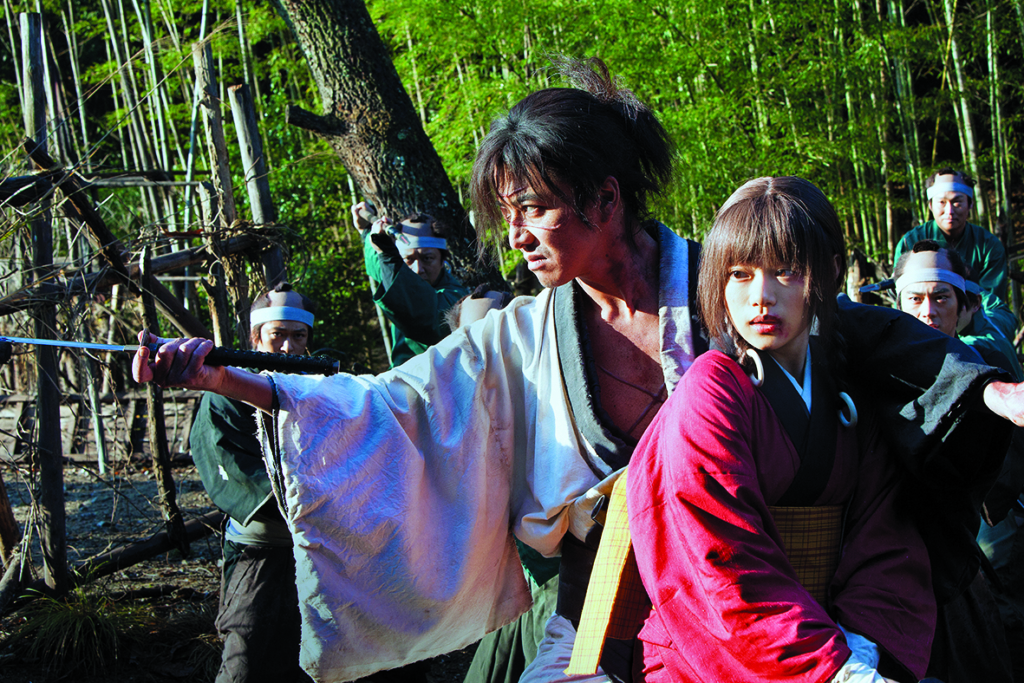
A filmography of the sheer volume of Miike’s is difficult for any commentator to get a grasp on, and that’s without even factoring in the diversity and relative inaccessibility of some of his work. Miike’s enormously varied oeuvre includes straight-to-video films, theatrical features, educational films and animated shorts (not to mention his extensive television work) – among them, sundry horror stories, supernatural adventures, serial-killer flicks, musicals, romances, historical dramas, westerns, yakuza sagas, vampire sagas, a yakuza-vampire saga and even (perhaps most obscurely) a tribute to a World War II Japanese submariner who participated in a 1942 assault on Sydney Harbour. This curio, titled Keiu Matsuo and His Mother (2007), is only available from the gift shop at the Yasukuni Shrine, a Tokyo war memorial controversial for its valorisation of convicted war criminals.[3]Grady Hendrix, ‘Kaiju Shakedown: Takashi Miike’, Film Comment, 24 September 2014, <https://www.filmcomment.com/blog/kaiju-shakedown-takashi-miike/>, accessed 14 February 2018.
How does anyone begin to make sense of a career like that? Predictably, in English-language discourse, commentators have long reached for terms most familiar to Western audiences. In 2004, British critic Robin Wood wrote in praise of Audition, pinpointing the film’s structural likeness to Alfred Hitchcock’s Vertigo (1958)[4]Robin Wood, ‘Revenge Is Sweet: The Bitterness of Audition’, Film International, vol. 2, no. 1, issue 7 January 2004, pp. 22–7, available at <http://filmint.nu/?p=42>, accessed 15 March 2018. – this rhetorical move is undoubtedly the ne plus ultra of legitimising a film within Western cineaste circles.
Blade of the Immortal hints at a Miike capable of bending the chanbara form to his own sensibility, satisfying the imperatives of international markets by producing something traditional in appearance while still indulging his peccadillos.
The sensationalistic violence in much of Miike’s work has seen him lumped into the ‘Asia Extreme’ rubric,[5]See, for example, Alicia Lewis, ‘Animalistic Depravity: Takashi Miike’s The Mole Song: Undercover Agent Reiji’, Metro, no. 184, Autumn 2015, pp. 52–5. alongside nationally diverse filmmakers like South Korea’s Park Chan-wook, Japan’s Hideo Nakata and Hong Kong’s Fruit Chan. This terminally vague concept was always more of a marketing label than a tool for understanding the films, and it has since waned in usefulness as some of its ‘practitioners’ have moved into fresh creative territory (Miike is also not the only one from this cohort to graduate into international respectability – Park and Kiyoshi Kurosawa have likewise become festival fixtures and found international production support).
The issue of violence is, for better or worse, a central consideration in terms of Miike’s critical reception. Prior to his chanbara period, his most well-known films – Audition, Ichi the Killer, Dead or Alive (1999) – each made an impression through their audacious depictions of brutality, gore and sexual perversion. This transgressive sensibility was a significant lens through which critics attempted to make sense of his work. Scholar Tony Williams has argued that Miike enacts a ‘cinema of outrage’ in response to seismic changes in Japanese culture brought on by the effects of globalisation. In this reading, the undermining of traditional cultural values effected by globalisation is reflected in Miike’s films’ nihilistic content (like Wood, Williams attempts to make the Japanese director explicable by reference to a British auteur, suggesting, half-facetiously, that he might be called the ‘“Ken Russell” of Japanese cinema’).[6]Tony Williams, ‘Takashi Miike’s Cinema of Outrage’, CineAction, issue 64, August 2004, pp. 54–62.
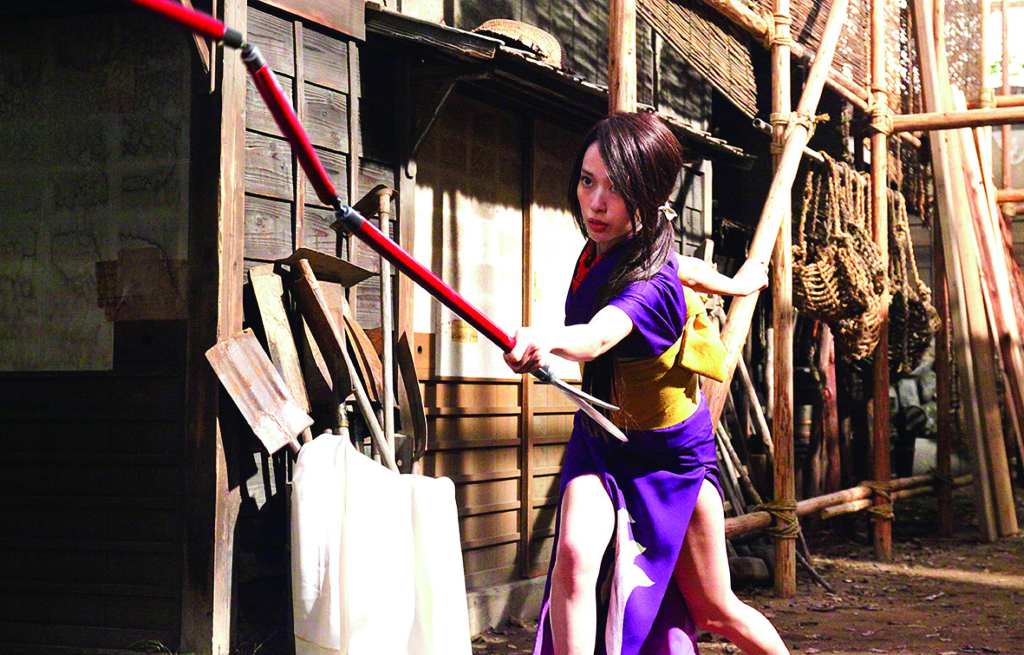
If his earlier transgressive work represents a kind of adolescent middle digit raised towards society, then, the thinking seems to go, the chanbara films are Miike grown-up. I am not at all a Miike completist (is such a thing possible?), but 13 Assassins is, indeed, to my mind, the most conventionally thrilling film I’ve seen from him – a deeply satisfying revenge narrative, happily intensified by Miike’s aptitude for screen violence and executed with the formal panache of an old hand. Hara-Kiri seems to be a further step into classicism; despite its faddish embrace of 3D filmmaking, the film is very much an old-fashioned melodrama, realised in a fluidly measured style. The notion that Miike’s chanbara phase represents a maturation of his talents and sensibility may be a misguided one, though. In his review of the film, long-time Miike scholar Tom Mes points out that 13 Assassins’ international edit elides moments of tonal playfulness and coarse humour, thus contributing to the misperception that the director has curtailed his eccentricities.[7]Tom Mes, ‘Review: 13 Assassins’, Film Comment, vol. 47, no. 3, May/June 2011, pp. 64–5, available at <https://www.filmcomment.com/article/13-assassins-review/>, accessed 15 January 2018.
Neither conventionally satisfying (like 13 Assassins) nor formally restrained (like Hara-Kiri), Blade of the Immortal hints at a Miike capable of bending the chanbara form to his own sensibility, satisfying the imperatives of international markets by producing something traditional in appearance while still indulging his peccadillos. It’s not surprising that Miike, when offered the job of directing the film after years of stalled versions from other filmmakers, said, ‘I believe it was my destiny to be on board this project.’[8]Takashi Miike, quoted in Tom Grater, ‘Takashi Miike Talks Blade of the Immortal and Cannes’, Screen Daily, 18 May 2017, <https://www.screendaily.com/features/takashi-miike-talks-blade-of-the-immortal-and-cannes/5117953.article>, accessed 14 February 2018. The black-and-white prologue alone runs the gamut from melodrama to mass slaughter, complete with dashes of grotesque fantasy – as when the witch Yaobikuni (Yōko Yamamoto) implants Manji with the ‘blood worms’ that ensure his immortality – and scatological humour (one character mistakes for a rice ball what is, in fact, a horse turd).
At one point in Blade, Anotsu announces his intention to eliminate all other sword-fighting schools in order to revivify warrior culture in Japan – razing the tired old order so that a Darwinian struggle can begin. As far as villainous motivations go, it’s not so different from the desires of the psychotic Lord
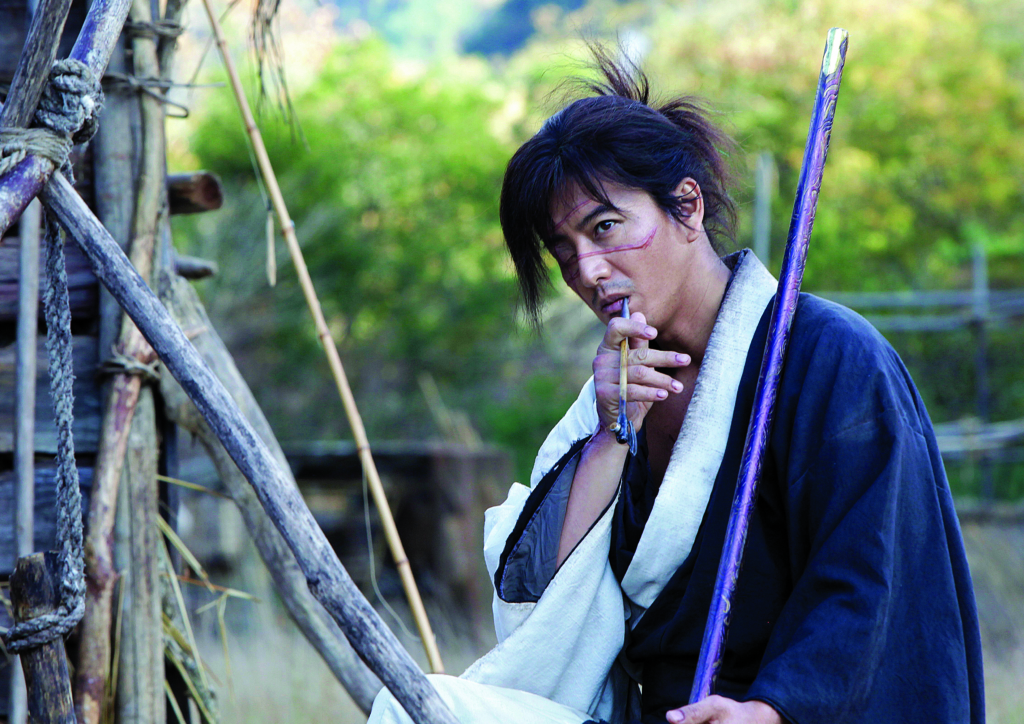
Naritsugu (Gorō Inagaki) in 13 Assassins: aroused by the attempts on his life, he declares that, when he ascends to power in the shogunate court, he will orchestrate a time of war so that clans can test their mettle in battle again. And this vision of samurai/warrior clans as, essentially, rival gangs fighting for supremacy and disrupting the general peace is itself not so different, in broad strokes, from the dynamics of the yakuza stories that recur throughout Miike’s career.
In this sense, the chanbara form is not so much a new stage for Miike as a new set dressing with which to enact his old interests. The generic conventions common to chanbara films – lone warriors, centrepiece spectacles, revenge-and-justice plots – are present not only in 13 Assassins and Blade, but also in other recent Miike work like Yakuza Apocalypse (2015) – the aforementioned yakuza-vampire saga that, though wildly different in its particulars, is a sibling to Blade in general theme and structure.
Scholar Mike Dillon has seen in Miike’s recurring interest in the yakuza – and outcast, ad hoc family units – a means of working through the question of multiculturalism and ethnic diversity within Japan’s putatively monocultural society.[9]Mike Dillon, ‘The Immigrant and the Yakuza: Gangscapes in Miike Takashi’s DOA’, Studies in the Humanities, vol. 39, no. 1–2, 2012, pp. 193–232. The idea that Miike might be strategically deploying the chanbara genre, perhaps the most traditional and culturally homogenous in all of Japanese cinema, in order to restate a career-long appeal to diversity has a nicely subversive air. ‘Against homogeneity’ may be not only the governing principle of Miike’s career choices, but his central thematic thread, too.
Endnotes
| 1 | Andreas Wiseman, ‘RPC Reteams with Takashi Miike on Blade of the Immortal’, Screen Daily, 13 February 2016, <https://www.screendaily.com/berlin/rpc-reteams-with-takashi-miike-on-blade-of-the-immortal/5100297.article>, accessed 14 February 2018. |
|---|---|
| 2 | Andrew Dorman, Paradoxical Japaneseness: Cultural Representation in 21st Century Japanese Cinema, Palgrave Macmillan, London, 2016. |
| 3 | Grady Hendrix, ‘Kaiju Shakedown: Takashi Miike’, Film Comment, 24 September 2014, <https://www.filmcomment.com/blog/kaiju-shakedown-takashi-miike/>, accessed 14 February 2018. |
| 4 | Robin Wood, ‘Revenge Is Sweet: The Bitterness of Audition’, Film International, vol. 2, no. 1, issue 7 January 2004, pp. 22–7, available at <http://filmint.nu/?p=42>, accessed 15 March 2018. |
| 5 | See, for example, Alicia Lewis, ‘Animalistic Depravity: Takashi Miike’s The Mole Song: Undercover Agent Reiji’, Metro, no. 184, Autumn 2015, pp. 52–5. |
| 6 | Tony Williams, ‘Takashi Miike’s Cinema of Outrage’, CineAction, issue 64, August 2004, pp. 54–62. |
| 7 | Tom Mes, ‘Review: 13 Assassins’, Film Comment, vol. 47, no. 3, May/June 2011, pp. 64–5, available at <https://www.filmcomment.com/article/13-assassins-review/>, accessed 15 January 2018. |
| 8 | Takashi Miike, quoted in Tom Grater, ‘Takashi Miike Talks Blade of the Immortal and Cannes’, Screen Daily, 18 May 2017, <https://www.screendaily.com/features/takashi-miike-talks-blade-of-the-immortal-and-cannes/5117953.article>, accessed 14 February 2018. |
| 9 | Mike Dillon, ‘The Immigrant and the Yakuza: Gangscapes in Miike Takashi’s DOA’, Studies in the Humanities, vol. 39, no. 1–2, 2012, pp. 193–232. |
